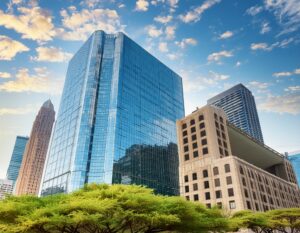- High Vacancy Rates: The Dallas-Fort Worth office market faces a 20-year high vacancy rate of 18%, having increased by 330 basis points since the end of 2019. This rate is among the highest in the country.
- Net Move-Outs: Tenants have vacated 1.8 million square feet more than they have absorbed, to potentially record the largest volume of net move-outs.
- Economic Headwinds: The market is experiencing further economic challenges and anticipates reduced demand due to the potential of a near-term recession.
- Future Vacancy Expectations: CoStar predicts that vacancy rates will rise further, potentially reaching close to 20%, reminiscent of the late 1980s’ market conditions post the S&L crisis and energy downturn.
- Return-to-Office Efforts: Dallas has led return-to-office efforts with office attendance trending near 50%, though it has stalled over the past year. Companies like AT&T have implemented return-to-office plans requiring managers to be in the office three days a week.
- Suburban vs. Urban Market Performance: Suburban submarkets have shown resilience with 2 million square feet of net absorption over the past year, while urban submarkets reported 2 million square feet of net move-outs.
- Construction Trends: Office construction is progressing at a manageable pace, with 7.3 million square feet underway. Uptown, Dallas’s premier office node, accounts for 25% of this construction, reflecting confidence in high-density, mixed-use concepts.
- Market Rent Growth: Rent growth remains stable but is expected to decline in the near term. High-quality areas like Uptown and Preston Center continue to perform better on rent growth.
- Sublease Market: Elevated sublease space offers prospective tenants significant discounts, especially in urban areas, with relative discounts ranging from $6-$10 per square foot.
- Office Sales: Office sales are slowing due to rising interest rates, leading to increased caution among buyers. However, well-leased, higher-end assets in prime locations still attract investor interest, maintaining higher market pricing.
Page Contents
- Vacancy Rates Rising
- Demand in Suburban Areas
- Build-to-Suit Projects
- Downtown Dallas Challenges
- Office-to-Residential Conversions
- Elevated Sublet Availability
- Corporate Relocations and Expansions
- Incentive Packages
- Economic Development Competitor
- Future Outlook
- Stabilizing Rent Growth
- Future Outlook for Rent Growth
- High Rents in Premium Submarkets
- Growth in Northern Suburban Submarkets
- Manageable Construction Pace
- Concentration in Uptown/Turtle Creek
- Significant Groundbreakings
- Granite Properties and Bank of OZK
- Suburban Construction
- Build-to-Suit Projects
- Decade of Growth
- Corporate Headquarters
- Medical Office Space
- Sales Activity Slows
- High-Quality Office Spaces
- Trammell Crow Center Sale
- Former JCPenney Headquarters
- Closing Thoughts
Vacancy Rates Rising
Vacancy rates in Dallas-Fort Worth have trended higher over the past year due to increased move-outs. The market reported -4.2 million square feet vacated, pushing vacancy rates to 18%. Office demand is expected to remain low as firms reassess their office needs. The base case scenario predicts vacancy rates to rise to 22% by 2025.
Demand in Suburban Areas
 Despite the high vacancy rates, demand persists in high-quality suburban office nodes in Collin County. Areas like Allen/McKinney, Frisco/The Colony, and Upper Tollway/West Plano have reported net absorption above 300,000 square feet in the past year. These faster-growing suburban submarkets are supporting overall office demand. Large build-to-suit projects have significantly contributed to this trend.
Despite the high vacancy rates, demand persists in high-quality suburban office nodes in Collin County. Areas like Allen/McKinney, Frisco/The Colony, and Upper Tollway/West Plano have reported net absorption above 300,000 square feet in the past year. These faster-growing suburban submarkets are supporting overall office demand. Large build-to-suit projects have significantly contributed to this trend.Build-to-Suit Projects
Several large build-to-suit projects have boosted net absorption in suburban areas. Charles Schwab moved into its 580,000-square-foot Westlake Campus. Paycom occupied a new 150,000-square-foot facility, and JPMorgan Chase moved into a 540,000-square-foot space in Legacy West. These moves highlight the appeal of custom office spaces in the suburbs.
Downtown Dallas Challenges
Meanwhile, downtown Dallas continues to lose occupancy, pushing vacancy rates higher. Some vacancies are due to new owners vacating spaces for office-to-residential conversions. For example, Todd Interests purchased Energy Plaza and vacated its 1.2 million square feet. This trend follows other significant conversion projects in the area.
Office-to-Residential Conversions
Office-to-residential conversions are becoming more common in downtown Dallas. Todd Interests converted the 1.2 million-square-foot tower at 1401 Elm into 324 multifamily units, a hotel, and ground-floor retail. These projects are reshaping the downtown landscape, contributing to the area’s transformation.
Elevated Sublet Availability
The market is also facing elevated sublet availability, with 11.4 million square feet on the market. Some tenants are leveraging the flexibility and shorter lease terms of subleases. The market matched the previous year’s total of 1.6 million square feet of leasing activity in 2022. Sublease activity has particularly increased in areas with a high concentration of Class A and trophy assets.
Corporate Relocations and Expansions
Corporate relocations and expansions continue to fuel office demand in Dallas-Fort Worth. The region’s highly skilled labor force, business-friendly environment, and central location are major draws. Additionally, the metroplex’s robust air transportation network enhances its appeal to office-using employers.
Incentive Packages
Aggressive incentive packages offered by Texas and local municipalities are also attracting firms. These incentives place Dallas-Fort Worth at the top of the list for companies seeking to establish or expand their presence. The combination of economic incentives and a favorable business climate is a significant advantage.
Economic Development Competitor
Dallas-Fort Worth’s attributes make it a strong competitor for economic development. The region’s central location and global connectivity through air transportation are key benefits. These factors, combined with a skilled workforce and supportive local policies, enhance the area’s attractiveness to businesses.
Future Outlook
While challenges remain, Dallas-Fort Worth’s office market shows resilience in certain areas. Suburban markets are performing well, and office-to-residential conversions are revitalizing downtown spaces. Corporate interest, supported by favorable conditions, continues to drive demand, offering a balanced outlook for the future.
Stabilizing Rent Growth
Rent growth in Dallas-Fort Worth is stabilizing. The market has shown performances above 2% over the past several quarters. This growth outpaces the national average.
 However, future rent growth is expected to slow as demand remains fragile and firms re-evaluate their space needs.
However, future rent growth is expected to slow as demand remains fragile and firms re-evaluate their space needs.Future Outlook for Rent Growth
The analysts’ outlook predicts rent growth to soften. The market’s future demand remains vulnerable. This cautious outlook reflects ongoing economic uncertainties. Firms’ reassessment of space needs will continue to impact rent growth.
High Rents in Premium Submarkets
The highest market rents are in submarkets with many 4 and 5 Star buildings. Uptown/Turtle Creek and Preston Center have average market rents of over $40 per square foot. Uptown/Turtle Creek also reports the second-highest rent growth at 4.4%. Trophy assets in these areas reach up to $48 per square foot.
Growth in Northern Suburban Submarkets
The northern suburban submarkets of Frisco/The Colony and Upper Tollway/West Plano report market rents of $35 per square foot. Several high-quality asset deliveries over the past few years have driven this growth. Frisco’s developments, like Frisco Station, have market rents of $36 per square foot, and the Star reports estimated rents of $50 per square foot.
Manageable Construction Pace
The pace of construction in Dallas-Fort Worth is manageable, with 7.3 million square feet underway. Construction levels have remained flat since the beginning of 2022. Uncertainty in the office market, rising sublease space, and supply chain disruptions weigh on development. Ongoing construction labor shortages also impact progress.
Concentration in Uptown/Turtle Creek
Most office construction is concentrated in the Uptown/Turtle Creek Submarket. Developers have launched several projects over the past year. Construction levels hit 1.8 million square feet, accounting for 25% of all office development. This is the highest volume since mid-2016.
Significant Groundbreakings
In 2022, developers initiated 1.6 million square feet of new construction. Harwood is progressing with the 359,000-square-foot Harwood No 14 in Uptown. The building is 70% preleased, with Dallas’ largest law firm, Haynes and Boone, taking 125,000 square feet. Nearby, Stream is advancing The QUAD, a 339,000-square-foot building with unique amenities.
Granite Properties and Bank of OZK
Granite Properties closed construction financing for 23Springs, a 626,200-square-foot development. Bank of OZK signed a 110,000-square-foot lease. The building is expected to deliver in mid-2025. These developments reflect ongoing confidence in high-quality office spaces.
Suburban Construction
Suburban submarkets also see new construction. Billingsley is adding 476,000 square feet to Cypress Watters. This innovative office park is a short drive to D/FW International Airport. Paycom completed the first phase of its Grapevine campus, a 150,000-square-foot operations center.
Build-to-Suit Projects
Build-to-suit projects are prominent in the Dallas-Fort Worth office market. Goldman Sachs plans a 950,000-square-foot project, expected to break ground this year. Wells Fargo is set to build an 800,000-square-foot campus in Irving. These projects will significantly boost net absorption.
Decade of Growth
Over the past decade, 66.3 million square feet of new office space has been added. This represents 16% of the total inventory. New buildings command rents over $35 per square foot and have a vacancy rate of 12%. Corporate relocations and expansions have driven this growth.
Corporate Headquarters
Around 14 million square feet of the new inventory is owner-occupied. Major headquarters include Toyota, American Airlines, and Liberty Mutual. These buildings have significantly contributed to the market’s expansion. Their presence has strengthened Dallas-Fort Worth’s appeal.
Medical Office Space
Strong population growth, especially in northern suburbs, has increased demand for medical office space. Consequently, 13.2 million square feet of medical office space has been added. This growth underscores the diverse needs of the expanding population.
Sales Activity Slows
Sales activity in Dallas-Fort Worth has slowed as rising interest rates have increased the cost of debt. Asset prices are falling, and cap rates are rising. Investors are still drawn to the metroplex’s economic resilience and strong track record of attracting and retaining companies. These factors make Dallas-Fort Worth appealing compared to coastal markets with higher barriers to entry.
High-Quality Office Spaces
Investors remain interested in high-quality spaces in well-placed office centers. For instance, McKinney & Olive was purchased for $394.7 million by a joint venture between Granite Properties and Highwoods Properties. This deal, at $708 per square foot, set a high price boundary for office space in the area. It shows that trophy assets in premier locations will continue to attract investor interest.
Trammell Crow Center Sale
The Trammell Crow Center sold for over $600 million in 2022. The 50-story building on Ross Avenue was acquired by Regent Properties, a California-based investor. The previous owners spent over $180 million on upgrades, attracting new and expanding tenants. Notable tenants include ORIX USA, Gibson Dunn & Crutcher LLP, and Goldman Sachs.
Former JCPenney Headquarters
Capital Commercial Investments, based in Austin, purchased the former JCPenney headquarters in Plano. The company plans to spend $3 million to $4 million on amenity upgrades. Capital Commercial is known for repurposing office campuses. They previously bought the former American Airlines campus and signed a 109,000-square-foot lease shortly after.
Closing Thoughts
The Dallas-Fort Worth office market shows resilience amid challenges. High-quality assets continue to attract investors. Suburban growth and build-to-suit projects drive demand. For your investment needs, contact Lumicre.